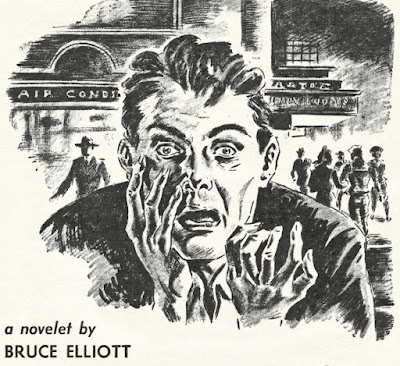Esteemed MAM historians Robert Deis and Wyatt Doyle have collected these stories into a mammoth volume aptly titled Exotic Adventures of Robert Silverberg. It is part of the duo's The Men's Adventure Library published by New Texture. The book features an informative introduction regarding both Silverberg and his contributions to MAMs, as well as the publication history on the short-lived Exotic Adventures magazine.
In this intro, I thoroughly enjoyed the education on Silverberg's paperback sleaze novels. The author penned many genre novels for the sleaze publishers like Beacon, Regency, Midnight Reader, and Nightstand. There's an excellent backstory here on William Hamling, who played a prominent role in Silverberg's early success as a writer, including the sex novels and sexology articles that the author wrote. There is also information on Silverberg joining Scott Meredith's agency. Meredith was the premier literary agent of that era, and Deis and Doyle point out that Meredith sold excerpts from Silverberg's sex books to the MAMs to use for their shorts. This was the same thing that was happening with Lawrence Block during that time as well.
I really enjoy adventure stories, and this volume is packed with some really good Silverberg stories that feature promiscuous women, admirable heroes, and exotic locations. Most of the themes are sex-oriented, with adventurers pushed to the brink of death by some folly they made with a vivacious woman. Nothing showcases that theme more than “Safari of Death”, a short story originally featured in the magazine's third issue with Silverberg using the pseudonym Leon Kaiser. Like many of these MAM stories, the author is the main character and the presentation is first-person. In this story, Kaiser (a married man) relays an affair he had with a married woman on a safari hunt in the French Cameroons. Before the hunt is through, Kaiser learns more about this woman's character and the extreme nature of her lust. Needless to say, “Safari of Death” ends with a grisly scene.
The best story in this volume is “Trapped by Mau Mau Terror”, a short originally published in issue four using a Silverberg pseudonym of Norman Reynolds. The story is set in Kenya during a time when the Kikuyu tribe was on a violent rise to power under the name Mau Mau. The protagonist explains in the first-person how he came to manage a farm in Nairobi. At 30 years of age, with Korean War experience, this young man finds himself in the arms of a woman on a night of horrifying bloodshed. Inside a farm house, the man and his lover fight off hordes of blood-crazed savages over the course of a very violent evening. This was a high-intensity, large body-count as Silverberg and his heroes methodically clear the house of intruders. In some ways, this reminded me of another MAM story called “Night Visit”, which was published in Adam in October 1976 (author and artist unknown).
It wouldn't be a true MAM omnibus without at least one killer-crab story. The book gives the readers what they want with “Attacked by Monster Crabs”, featured in the magazine's third issue under the pseudonym Dave Callahan. This is a fun, rather meaningless story about a guy and his lover attacked by pinching monstrosities near Belize. Another highlight of the book is a more serious entry called “I Escaped from the Soviet Slave Camp”, featured in the sixth issue under the name Anna Lukacs. In first-person, Lukacs details the horrific invasion of Hungary by the Soviets and her enslavement as a sex-slave. While certainly not the same overtones, the violence and sadistic savagery of this story was similar to a 1967 book I recently read and reviewed called Tortured for Christ, however the focus was on the Soviet's invasion and atrocities committed in Romania. Silverberg's story is excellent and provided a harsh look at the historic horrors perpetrated by the notorious Soviet empire.
Exotic Adventures of Robert Silverberg is worth its weight in gold and contains some fantastic stories. While this author will forever be ingrained in science-fiction and fantasy, his other literary work was just as exceptional and memorable. I'm glad that Robert Deis and Wyatt Doyle recognized the need to bring these stories to light. They continue to impress with each and every volume. Highly recommended!
Buy a copy of this book HERE.






















